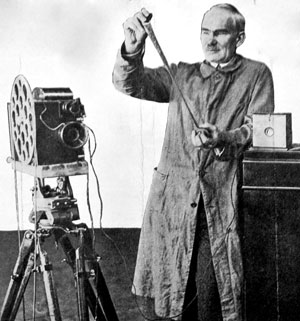Arts
Lee de Forest: King of Radio, Television and Film
Lee de Forest
 RADIO ACTIVATOR: Local inventor Lee de Forest developed the technology that made modern media possible.
RADIO ACTIVATOR: Local inventor Lee de Forest developed the technology that made modern media possible.
In Palo Alto, about a century ago, a man named Lee de Forest invented the three-element vacuum tube. With his typical sense of poetry, he named it "the Audion.' Superseded by other advances in amplification, the device exists, when it does, in those high-end tube amps that electric guitarists purchase.
This invention, however, gives credence to what SJSU associate dean Mike Adams calls the subject of his biography: Lee de Forest: King of Radio, Television and Film ($27.95; Copernicus Books/Springer)
De Forest was a genius, but a troubling and troubled one, a model for the embittered crackpot beloved of science fiction. Says Adams, de Forest believed "that an unnamed 'they' were out to get him' as early as the 1890s, even before the inventor entered Yale.
He was a famous man, a highly successful inventor who made a million dollars from one of his patents. And he was much-married: the fourth time to a very pretty, if forgotten, Hollywood actress.
De Forest was also cranky enough to write to the newspapers that "his' invention, radio, had been perverted by all that cheap music the disk jockeys played, that "hubba hubba and audio jitter bug ... a stench in the nostrils of the gods of the ionosphere.'
Ultimately, radio had multiple fathers. Adams stresses de Forest's neglected rep as the pioneer of sound film. The author has a local historian's sympathy for de Forest, whose artifacts, including the honorary Oscar he won in 1960, are kept at History San Jose.
Adams reminds us of "the humanist who sees poetry and music where others like Marconi see only dots and dashes and dollars.'
De Forest was a writer of poetry and a lover of opera, and from a poor background, unlike the well-born and well-connected Marconi. Moreover, it was this very love of classical music that made de Forest conceive of the uses of radio and sound film for music, instead of just commerce.
It also helped make de Forest one of the earliest electronic-music performers, via the so called "Audion piano.' And de Forest devised a way to put sound photographically on film strips instead of through a separate turntable apparatus. The idea of sound on film dates back to the 1880s, but de Forest conquered the problem of synchronization.
Adams suggests a reason that de Forest isn't better known for this invention: Though he was a tireless self-publicizer, he was a bad businessman, arrested once in Palo Alto for suspicion of peddling worthless stock. "I'm not a crook,' he told an unknown correspondent. Call it Nixon's Law: A person should never be in the position of having to say those words.
Involvement with dodgy associates contributed to what Adams describes as de Forest's "murky ethics record.' And he loved to sue rivals. One of his cases went all the way to the Supreme Court, where some believe de Forest was a victor simply because Justice Cardozo didn't really understand the matter at hand.
Speaking of misunderstanding, this, too, was de Forest's problem. He had a weak idea of the power of silent cinema and the importance of stars. De Forest's Phonofilm shorts of the early 1920s were static (once highlighting the speechifying of Calvin Coolidge). The public went ape for Al Jolson and the phonograph disk–driven Vitaphone system; Adams suggests the public and the exhibitors weren't as impressed by de Forest's "laboratory experiments posing as cinema.'
As a longtime teacher, Adams finds the anecdotes that make de Forest relevant. His courtship via radio code of his first wife Lucille "might be compared to the text messaging of today.' The author describes strange devices before the Audion and after: the "singing arc,' the "speaking flame' and de Forest's proposal for gas fire–powered telephones.
The discursions are worth the trip, too. We learn the tidbit that the very early narrative film The Great Train Robbery was followed by what is likely the first sequel in movie history: The Little Train Robbery (1912), with an Our Gang–like group of banditos robbing a miniature train. Adams, who has also chronicled our local radio titan Charles Herrold, explains the various tides in de Forest's career with familiarity, affection, skepticism and a definite sense of marvel.
Lee de Forest: King of Radio, Television and Film
By Mike Adams
Copernicus Books/Springer; $27.95


